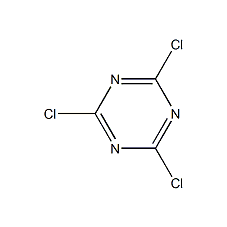Cyanuric chloride 2,4,6-Trichloro-1,3,5-triazine


Structural formula
| Business number | 02XW |
|---|---|
| Molecular formula | C3Cl3N3 |
| Molecular weight | 184.41 |
| label |
Chlorine tripolychloride, cyanogen chloride, Cyanuric acid chloride, Trichlorocyanuric acid, cyanuric chloride, Cyanuric Chloride, cyanuric acid chloride, cyanuric chloride, ,3,5-Trichloro-2,4,6-triazine, 1,3,5-Triazine, 2,4,6-trichloro-, 1,3,5-Triazine,2,4,6-trichloro-, 1,3,5-Trichlorotriazine, 2,4,6-Trichlor-[1,3,5]triazin, 2,4,6-Trichloro-s-triazin, Heterocyclic compounds |
Numbering system
CAS number:108-77-0
MDL number:MFCD00006046
EINECS number:203-614-9
RTECS number:XZ1400000
BRN number:124246
PubChem number:24857235
Physical property data
1. Characteristics: White crystals, pungent smell, easy to absorb moisture and generate heat, and release smoke gas.
2. Density (g/mL, 20℃): 1.32
3. Relative vapor density (g/mL, air=1): 6.36
4. Melting point (ºC): 145.8
5. Boiling point (ºC, normal pressure): 194
6. Boiling point (ºC, mm Hg): Undetermined
7. Refractive index (D20): Not determined
8. Flash point (ºC): Not determined
9. Specific rotation (ºC): Undetermined
10. Autoignition point or ignition temperature (ºC): Undetermined
11. Vapor pressure (mmHg, ºC): Undetermined
12. Saturated vapor pressure (kPa, 70 ºC): 0.27
13. Heat of combustion (KJ/mol): Undetermined
14. Critical temperature (ºC): Undetermined
15. Critical pressure (KPa): Undetermined
16. Log value of oil-water (octanol/water) partition coefficient: Undetermined
17. Explosion upper limit (%, V/V): Undetermined
18. Explosion lower limit (%, V/V): Undetermined
19. Solubility: Slightly soluble in water, soluble in alcohol, chloroform, carbon tetrachloride, acetone, dioxane, and hot ether.
Toxicological data
1. Skin/eye irritation
Standard Draize test: rabbit, skin contact: 500mg/24H, severity of reaction: moderate.
Standard Draize�Test: Rabbit, eye contact: 50μg/24H, severity of reaction: severe.
2. Acute toxicity: rat oral LD50: 485mg/kg; mouse oral LD50: 350mg/kg; mouse inhalation LC50: 10mg/m3/ 2H; Mouse intraperitoneal LD50: 10mg/kg; Mouse intravenous LD50: 18mg/kg;
3. Other multiple dose toxicity: Rat oral TDLo: 2800mg/kg/28D-C;
Rats inhale TCLO: 1880 μg/m 3 /4H/11W-I;
4. Chronic toxicity/carcinogenic
Oral TDLo in rats: 20mg/kg/73W-I; Rat TDLo via multiple lines: 16mg/kg/73W-I
Ecological data
This substance is harmful to the environment, and special attention should be paid to the pollution of water bodies.
Molecular structure data
1. Molar refractive index: 35.21
2. Molar volume (cm3/mol): 104.9
3. Isotonic specific volume (90.2K ): 297.3
4. Surface tension (dyne/cm): 64.3
5. Polarizability (10-24cm3): 13.95
Compute chemical data
1. Reference value for hydrophobic parameter calculation (XlogP): 2.9
2. Number of hydrogen bond donors: 0
3. Number of hydrogen bond acceptors: 3
4. Number of rotatable chemical bonds: 0
5. Number of tautomers: none
6. Topological molecule polar surface area 38.7
7. Number of heavy atoms: 9
8. Surface charge: 0
9. Complexity: 69.3
10. Number of isotope atoms: 0
11. Determine the number of atomic stereocenters: 0
12. Uncertain number of atomic stereocenters: 0
13. Determine the number of chemical bond stereocenters: 0
14. Number of uncertain chemical bond stereocenters: 0
15. Number of covalent bond units: 1
Properties and stability
Avoid contact with moist air. Avoid contact with strong oxidants, strong acids, water, and alcohols.
Storage method
Stored in a cool, dry and well-ventilated warehouse. Keep away from fire and heat sources. Keep container tightly sealed. They should be stored separately from oxidants, acids, alcohols, and food chemicals, and avoid mixed storage. Equipped with the appropriate variety and quantity of fire equipment. Suitable materials should be available in the storage area to contain spills.
Synthesis method
The production of cyanuric chloride usually consists of two processes: cyanogen chloride preparation and cyanogen chloride polymerization. There are many methods to generate cyanogen chloride, such as the synthesis method of methyl thiocyanate and chlorine, the synthesis method of dissolving hydrocyanic acid in chloroform and passing chlorine gas, the hydrocyanic acid method, the sodium cyanide method, the urea method, and the hydrocyanic acid method. The current industrial production of cyanuric chloride generally uses two methods: sodium cyanide and hydrocyanic acid as raw materials. 1. Sodium cyanide method: Use sodium cyanide as raw material to react with chlorine to form cyanogen chloride, which is then polymerized to form cyanuric chloride, which is then quenched and crystallized to obtain the product. Raw material consumption quota: sodium cyanide 1073kg/t, chlorine 1700kg/t. 2. The hydrocyanic acid method uses hydrocyanic acid as raw material and reacts with chlorine to form cyanogen chloride, which is then polymerized to form cyanuric chloride, which is then quenched and crystallized to obtain the product. Raw material consumption quota: hydrocyanic acid 500kg/t, chlorine 1200kg/t.
Purpose
Cyanogen chloride is an important intermediate for the production of highly efficient and low-toxic triazepine herbicides and insecticides. It is also an intermediate for the production of fluorescent whitening agents, reactive dyes for dyeing polyester and other synthetic fibers. body. It is also used in the production of synthetic resins, rubber, polymer antioxidants, explosives, fabric anti-shrink agents, surfactants, etc.
Mainly used to prepare reactive dyes, direct dyes, metal complex dyes, acid dyes, vat dyes or disperse dyes, etc. Such as direct lightfast yellow L-5R, reactive bright yellow X-6G, reactive bright yellow X-7G and other dyes.
